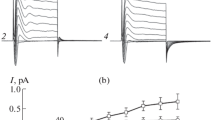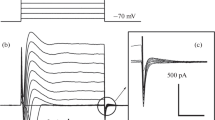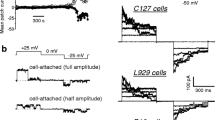Abstract
Acid-sensitive outwardly rectifying anion channels (ASOR) have been described in several mammalian cell types. The present whole-cell patch-clamp study elucidated whether those channels are expressed in erythrocytes. To this end whole-cell recordings were made in human erythrocytes from healthy donors treated with low pH and high osmotic pressure. When the pipette solution had a reduced Cl− concentration, treatment of the cells with Cl−-containing normal and hyperosmotic (addition of sucrose and polyethelene glycol 1000 [PEG-1000] to the Ringer) media with low pH significantly increased the conductance of the cells at positive voltages. Channel activity was highest in the PEG-1000 media (95 and 300 mM PEG-1000, pH 4.5 and 4.3, respectively) where the current–voltage curves demonstrated strong outward rectification and reversed at −40 mV. Substitution of the Cl−-containing medium with Cl−-free medium resulted in a decrease of the conductance at hyperpolarizing voltages, a shift in reversal potential (to 0 mV) and loss of outward rectification. The chloride currents were inhibited by chloride channels blockers DIDS and NPPB (IC50 for both was ~1 mM) but not with niflumic acid and amiloride. The observations reveal expression of ASOR in erythrocytes.





Similar content being viewed by others
References
Alper SL, Vandorpe DH, Peters LL, Brugnara C (2008) Reduced DIDS-sensitive chloride conductance in Ae1−/− mouse erythrocytes. Blood Cells Mol Dis 41:22–34
Auzanneau C, Thoreau V, Kitzis A, Becq F (2003) A novel voltage-dependent chloride current activated by extracellular acidic pH in cultured rat Sertoli cells. J Biol Chem 278:19230–19236
Barry PH, Lynch JW (1991) Liquid junction potentials and small cell effects in patch-clamp analysis. J Membr Biol 121:101–117
Bernhardt I, Weiss E, Robinson HC, Wilkins R, Bennekou P (2007) Differential effect of HOE642 on two separate monovalent cation transporters in the human red cell membrane. Cell Physiol Biochem 20:601–606
Chen MF, Chen TY (2001) Different fast-gate regulation by external Cl− and H+ of the muscle-type ClC chloride channels. J Gen Physiol 118:23–32
Diewald L, Rupp J, Dreger M, Hucho F, Gillen C, Nawrath H (2002) Activation by acidic pH of CLC-7 expressed in oocytes from Xenopus laevis. Biochem Biophys Res Commun 291:421–424
Duranton C, Huber SM, Lang F (2002) Oxidation induces a Cl-dependent cation conductance in human red blood cells. J Physiol 539:847–855
Duranton C, Tanneur V, Lang C, Brand VB, Koka S, Kasinathan RS, Dorsch M, Hedrich HJ, Baumeister S, Lingelbach K, Lang F, Huber SM (2008) A high specificity and affinity interaction with serum albumin stimulates an anion conductance in malaria-infected erythrocytes. Cell Physiol Biochem 22:395–404
Egee S, Lapaix F, Decherf G, Staines HM, Ellory JC, Doerig C, Thomas SL (2002) A stretch-activated anion channel is up-regulated by the malaria parasite Plasmodium falciparum. J Physiol 542:795–801
Estevez R, Boettger T, Stein V, Birkenhager R, Otto E, Hildebrandt F, Jentsch TJ (2001) Barttin is a Cl− channel beta-subunit crucial for renal Cl− reabsorption and inner ear K+ secretion. Nature 414:558–561
Foller M, Kasinathan RS, Koka S, Lang C, Shumilina E, Birnbaumer L, Lang F, Huber SM (2008) TRPC6 contributes to the Ca2+ leak of human erythrocytes. Cell Physiol Biochem 21:183–192
Friedrich T, Breiderhoff T, Jentsch TJ (1999) Mutational analysis demonstrates that ClC-4 and ClC-5 directly mediate plasma membrane currents. J Biol Chem 274:896–902
Frohlich O, Leibson C, Gunn RB (1983) Chloride net efflux from intact erythrocytes under slippage conditions. Evidence for a positive charge on the anion binding/transport site. J Gen Physiol 81:127–152
Gunn RB, Wieth JO, Tosteson DC (1975) Some effects of low pH on chloride exchange in human red blood cells. J Gen Physiol 65:731–749
Huber SM, Uhlemann AC, Gamper NL, Duranton C, Kremsner PG, Lang F (2002) Plasmodium falciparum activates endogenous Cl− channels of human erythrocytes by membrane oxidation. EMBO J 21:22–30
Huber SM, Duranton C, Lang F (2005) Patch-clamp analysis of the “new permeability pathways” in malaria-infected erythrocytes. Int Rev Cytol 246:59–134
Ivanova L, Bernhardt R, Bernhardt I (2008) Nongenomic effect of aldosterone on ion transport pathways of red blood cells. Cell Physiol Biochem 22:269–278
Iyer R, Iverson TM, Accardi A, Miller C (2002) A biological role for prokaryotic ClC chloride channels. Nature 419:715–718
Jordt SE, Jentsch TJ (1997) Molecular dissection of gating in the ClC-2 chloride channel. EMBO J 16:1582–1592
Kaplan JH, Pring M, Passow H (1983) Band-3 protein-mediated anion conductance of the red cell membrane. Slippage vs ionic diffusion. FEBS Lett 156:175–179
Kasinathan RS, Foller M, Koka S, Huber SM, Lang F (2007a) Inhibition of eryptosis and intraerythrocytic growth of Plasmodium falciparum by flufenamic acid. Naunyn Schmiedebergs Arch Pharmacol 374:255–264
Kasinathan RS, Foller M, Lang C, Koka S, Lang F, Huber SM (2007b) Oxidation induces ClC-3-dependent anion channels in human leukaemia cells. FEBS Lett 581:5407–5412
Kim KH, Shcheynikov N, Wang Y, Muallem S (2005) SLC26A7 is a Cl− channel regulated by intracellular pH. J Biol Chem 280:6463–6470
Kummerow D, Hamann J, Browning JA, Wilkins R, Ellory JC, Bernhardt I (2000) Variations of intracellular pH in human erythrocytes via K+Na+/H+ exchange under low ionic strength conditions. J Membr Biol 176:207–216
Lambert S, Oberwinkler J (2005) Characterization of a proton-activated, outwardly rectifying anion channel. J Physiol 567:191–213
Lang F, Busch GL, Ritter M, Volkl H, Waldegger S, Gulbins E, Haussinger D (1998) Functional significance of cell volume regulatory mechanisms. Physiol Rev 78:247–306
Lang F, Gulbins E, Lerche H, Huber SM, Kempe DS, Foller M (2008) Eryptosis, a window to systemic disease. Cell Physiol Biochem 22:373–380
Marshall WS, Bryson SE, Sapp MM (1990) Volume regulation in glutathione-treated brook trout (Savelinus fontinalis) erythrocyts. Fish Physiol Biochem 8:19–28
Mo L, Hellmich HL, Fong P, Wood T, Embesi J, Wills NK (1999) Comparison of amphibian and human ClC-5: similarity of functional properties and inhibition by external pH. J Membr Biol 168:253–264
Morgan J, Leake DS (1993) Acidic pH increases the oxidation of LDL by macrophages. FEBS Lett 333:275–279
Nobles M, Higgins CF, Sardini A (2004) Extracellular acidification elicits a chloride current that shares characteristics with ICl(swell). Am J Physiol 287:C1426–C1435
Okada Y, Maeno E, Shimizu T, Manabe K, Mori S, Nabekura T (2004) Dual roles of plasmalemmal chloride channels in induction of cell death. Pfluegers Arch 448:287–295
Sabirov RZ, Prenen J, Droogmans G, Nilius B (2000) Extra- and intracellular proton-binding sites of volume-regulated anion channels. J Membr Biol 177:13–22
Sauve R, Cai S, Garneau L, Klein H, Parent L (2000) pH and external Ca2+ regulation of a small conductance Cl− channel in kidney distal tubule. Biochim Biophys Acta 1509:73–85
Tomlinson FH, Anderson RE, Meyer FB (1993) Brain pH i , cerebral blood flow, and NADH fluorescence during severe incomplete global ischemia in rabbits. Stroke 24:435–443
Verloo P, Kocken CH, Van der Wel A, Tilly BC, Hogema BM, Sinaasappel M, Thomas AW, De Jonge HR (2004) Plasmodium falciparum-activated chloride channels are defective in erythrocytes from cystic fibrosis patients. J Biol Chem 279:10316–10322
Wadiche JI, Amara SG, Kavanaugh MP (1995) Ion fluxes associated with excitatory amino acid transport. Neuron 15:721–728
Wang HY, Shimizu T, Numata T, Okada Y (2007) Role of acid-sensitive outwardly rectifying anion channels in acidosis-induced cell death in human epithelial cells. Pfluegers Arch 454:223–233
Yamamoto S, Ehara T (2006) Acidic extracellular pH-activated outwardly rectifying chloride current in mammalian cardiac myocytes. Am J Physiol 290:H1905–H1914
Yasui M, Hazama A, Kwon TH, Nielsen S, Guggino WB, Agre P (1999) Rapid gating and anion permeability of an intracellular aquaporin. Nature 402:184–187
Acknowledgements
We thank Dr. Ekaterina Shumilina for helpful advice and Prof. Dr. Ingolf Bernhardt for helpful discussion of the manuscript.
Author information
Authors and Affiliations
Corresponding author
Rights and permissions
About this article
Cite this article
Kucherenko, Y.V., Mörsdorf, D. & Lang, F. Acid-Sensitive Outwardly Rectifying Anion Channels in Human Erythrocytes. J Membrane Biol 230, 1–10 (2009). https://doi.org/10.1007/s00232-009-9179-z
Received:
Accepted:
Published:
Issue Date:
DOI: https://doi.org/10.1007/s00232-009-9179-z




